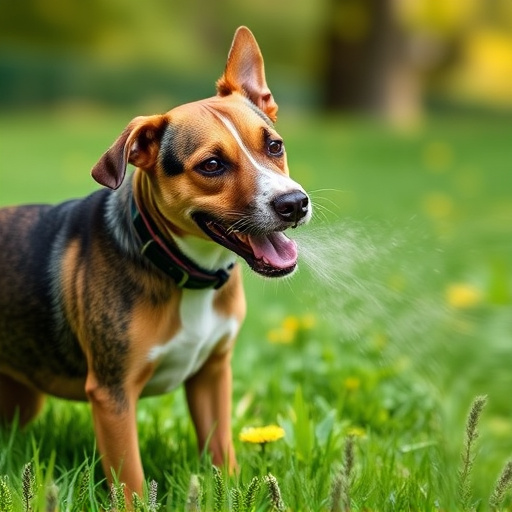Canine pepper spray temporarily disables aggressive dogs by irritating their eyes and throat from a distance of 3-10 meters (10-33 feet). Optimal deployment at close to mid-range distances ensures efficacy and user safety, adhering to the Canine Pepper Spray Deployment Distance Guide. Legal implications vary by region, so familiarize yourself with local laws before use.
Dog attack spray, also known as canine pepper spray, is a powerful tool for self-defense against aggressive dogs. This guide delves into the mechanics of its deployment, offering insights on optimal distance and safety protocols for effective use. We explore selection criteria, emphasizing the importance of understanding legal considerations and responsible usage practices. Learn how to navigate potential risks while harnessing the benefits of this innovative defense mechanism, ensuring your safety in canine-infested areas with a strategic approach based on our comprehensive Canine Pepper Spray Deployment Distance Guide.
- Understanding Dog Attack Spray Mechanics
- Selection Criteria for Optimal Distance
- Safety Protocols for Effective Deployment
- Legal Considerations and Responsible Use
Understanding Dog Attack Spray Mechanics
Dog attack spray, also known as canine pepper spray, is a non-lethal self-defense tool designed to temporarily disable aggressive dogs. Understanding how it works and its mechanics is crucial for effective deployment. When activated, the spray releases a potent solution that irritates the dog’s eyes, nose, and throat, causing them to retreat and temporarily lose aggression.
The deployment distance of canine pepper spray varies based on factors like the model, environmental conditions, and the user’s technique. As a general guide, a Canine Pepper Spray Deployment Distance of 3-10 meters (10-33 feet) is typical for most models to be effective. This range allows users to disable an attacking dog without putting themselves or others at risk of direct contact with the spray. Proper training and understanding the spray’s mechanics are essential to ensure its safe and effective use in real-life scenarios, especially when navigating a bustling urban environment where quick reactions and precise deployment can make all the difference.
Selection Criteria for Optimal Distance
When considering a canine pepper spray, one critical factor is the optimal deployment distance. This is determined by several key elements to ensure effectiveness and user safety. The first consideration is the range of the spray. Canine pepper spray typically has an effective range of 3 to 5 meters (10-16 feet). Beyond this range, the concentration of the spray may dilute too much to be impactful.
Additionally, the type of target plays a role. Whether it’s a large dog or multiple canines, closer proximity is generally required for the spray to take effect swiftly and severely enough to disable or deter the attack. Users should also consider their own reaction time and safety distance needed to avoid any potential counter-attacks. A general rule is to aim for deployment at close to mid-range distances, allowing for a safe retreat if necessary while maintaining effectiveness against the canine threat.
Safety Protocols for Effective Deployment
When considering a canine pepper spray deployment strategy, understanding safety protocols is paramount. It’s crucial to maintain a safe distance from the potentially aggressive dog while aiming for effective de-escalation. A general guide suggests keeping a minimum of 20 to 30 feet (approximately 6 to 9 meters) away from the animal, ensuring both your safety and minimizing cross-contamination. This distance allows you to deploy the spray while maintaining a safe perimeter, providing time for the dog to retreat or become immobilized.
Remember, timing and precision are key; aiming directly at the dog’s face or eyes can lead to faster de-escalation but requires meticulous control. In the Canine Pepper Spray Deployment Distance Guide, experts emphasize that staying within this recommended range significantly reduces risks associated with both deployment and potential bite injuries. Always follow safety guidelines, stay alert, and be prepared to react swiftly yet calmly during encounters with potentially dangerous dogs.
Legal Considerations and Responsible Use
When considering the use of dog attack spray, it’s crucial to be aware of legal implications and responsible deployment practices. Each jurisdiction has its own rules regarding the possession, carrying, and use of pepper spray, including specific guidelines for canine pepper spray. It’s essential to familiarize yourself with local laws before purchasing or employing any type of self-defense spray.
Responsible use involves understanding the effective deployment distance of the spray, often outlined in a canine pepper spray deployment distance guide. Proper technique ensures that the spray is directed accurately towards the threatening animal, minimizing harm to bystanders and pets. Users should also be trained on safe handling practices to prevent accidental discharge and potential injury. Remember, legal defenses for using pepper spray may vary, so knowing your rights and responsibilities is paramount.
Dog attack spray, also known as canine pepper spray, is a powerful tool for self-defense in potential dog attack scenarios. Understanding its mechanics, selecting the right deployment distance, adhering to safety protocols, and being aware of legal considerations are key to using it effectively and responsibly. This guide has provided insights into these critical aspects, equipping you with the knowledge to navigate and respond to high-risk situations involving dogs. Remember, proper training and a strategic approach to deployment can make all the difference in ensuring your safety and the effective use of this specialized spray.
